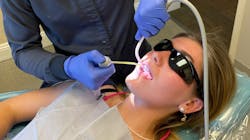Waterline warning: Dental practices, listen up
On October 31, 2022, the Centers for Disease Control (CDC) issued a Health Alert Network (HAN) Health Advisory, emphasizing the importance of prioritizing dental waterline maintenance. This alert came on the heels of a suspected outbreak of nontuberculous Mycobacteria (NTM) infections from dental unit waterlines (DUWL) at a pediatric dental clinic, which is still under investigation.
This makes the third such cluster of infections since 2015 where multiple children have been affected. And when I say affected, I don’t mean these kids had to take an antibiotic for 10 days and all was well. These patients have had multiple surgeries and lost permanent teeth and parts of their jaw. Many are permanently disfigured and or disabled because of these infections.
Listen up, dentistry: this is a big deal.
I like to call myself the Waterline Warrior. I’ve had the privilege of lecturing and consulting with offices across the country on the why and how of dental waterline protocols. It all began with my own journey from learning this is something we are supposed to do, to struggling to get my waterlines under the EPA required 500 CFU/ml for safe drinking water. I was thrilled to have the CDC issue this alert, but crushed that another group of patients has been affected by something that is entirely preventable.
So how can you ensure that this never happens in your office?
Like all tasks in dentistry, you need to have a written protocol and follow through with it. In each office, that protocol will vary, but some fundamentals will get you on the right track.
Shock
Shocking is using a strong disinfectant to blast through the biofilm that has settled in your DUWLs. There are many effective products on the market. Some are stronger than others, and some require multiple days to do the job. Read the instructions and follow them. Be sure to shock all the lines that have water flowing into them, especially if you don’t use them regularly–those are often the hiding place for biofilm.
When to shock:
- At the beginning of your waterline journey
- It only takes five days for biofilm to grow to 200,000 CFU/ml
- When you switch treatment products
- To remove any residue left behind
- After a two-week or more absence
- Because the biofilm had a party while you were gone
- When your waterline test reveals 200 CFU/ml
- Because 200 CFU will grow to well over 500 CFU in a matter of hours or days
- Consider quarterly or semi-annually
- This will help you stay ahead of a fail once you have a good system in place
Related reading
Dental unit waterlines: Trickier than you think
Test
The only way to know if your shock and follow-on treatment are working is to test. There are mail-in tests and in-office tests. My office does a mail-in test once a year (for third-party verification) and in-office tests the rest of the time. Much like shocking, you need to test all of the lines in your operatory. The good news is you can use one test per operatory and conduct a pooled sample, meaning you collect equal amounts of water from your air water syringe, power scaler, handpiece line, air polisher, and/or any other lines that have water going into them. A fail will send you back to shocking all the lines. A pass moves you on to treating your lines.
When to test:
- OSAP recommends testing monthly until you pass for two consecutive months
- Biofilm is sneaky and likes to go dormant and then grow back fast
- Once you are passing, move to quarterly testing
Treat
Treating is using a low-level antimicrobial to slow the growth of the biofilm. It’s kind of like brushing your teeth between hygiene visits; it keeps the biofilm down but doesn’t necessarily prevent its growth. Again, there are many treatment products on the market, but none are perfect and they need to be used in conjunction with periodic shocking.
How to treat:
- Choose a straw, tablet, or liquid
- Understand and follow the manufacturer's instructions for use
Maintain
Once you have your lines passing and have chosen the products you will use, mark it all into your office’s waterline protocol and document it as you go. When you fail, and a third of treated lines still fail (did I mention biofilm is a beast?), go back to step one, shock, and start all over again.
I’ve heard many times from dental professionals that they’ve been in practice for decades and have never made anyone sick. But the truth is you don’t know that you haven’t made anyone sick. In one of the outbreaks, the symptoms showed up between one and 409 days after exposure. And how about the health of your office team? The aerosols coming from your DUWLs are what you breathe all day long. The great thing about DUWL safety is there’s an easy way to test to ensure you are keeping everyone who walks into your office safe.
About the Author

Amanda Hill, BSDH, RDH, CDIPC
Amanda Hill, BSDH, RDH, CDIPC, is an enthusiastic speaker, innovative consultant, and award-winning author who brings over 25 years of clinical dental hygiene and education to dentistry. Recipient of OSAP’s Emerging Infection Control Leader award and an active participant with the advisory board for RDH magazine, DentistryIQ, and OSAP’s Infection Control in Practice Editorial Review Board and membership committee, Amanda (also known as the Waterline Warrior) strives to make topics in dentistry accurate, accessible, and fun. She can be reached at [email protected].
